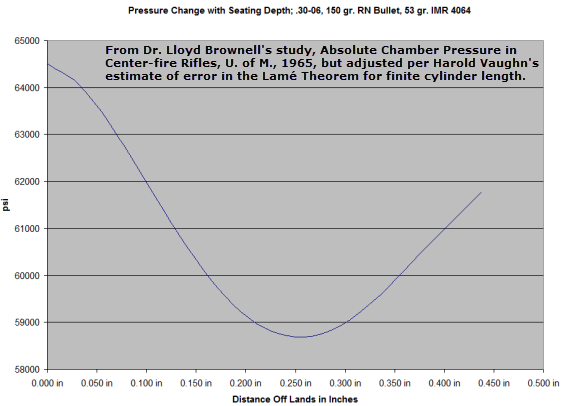Bytesniffer,
You answered your own question with the photos. The difference in the two measurements was 0.587". Add that number to any ogive measurement you make with that same comparator insert and you will have COL ± any variation in bullet length that lot of bullets has.
The Hornady gauge does not produce exact absolute measurements due to the hole radius. Neither does my copy of the RCBS Precision Mic, which measures a good quality (Dave Manson) headspace GO gauge off by about 0.002". The Hornady comparator is usually off around -0.004 to -0.008, with a few units getting outside that.
But it doesn't matter that the Hornady comparator is off of absolute. All you care about is the difference between the maximums in your chamber and what you set on the gauges. It's the jump and not its distance from the case head that matters. Also, the comparator and the RCBS PM both touch the bullet close to where your seating die presses down on it, so it's at the right place for making seating die adjustments that correspond well.
I think your use of 0.003" from the lands does not make sense for a couple of reasons. First, 0.003" doesn't make much difference to pressure, as the plot below reveals. It'll still be very close to the pressure you get from full contact with the lands, so it doesn't seem to be getting you any advantage in pressure. Second, bullets are less exact than that, owing to the fact they come off different sets of tooling that aren't perfectly identical and aren't set up and running on the same machine. As a result, the exact location of the part of the ogive that touches the lands can be off by 0.003". In the table below are the results of my measurements of 15 Sierra 150 grain MatchKings. You can see ogives differ by up to about 0.008" with respect to the base. I think you want to back off at least 0.020" to make your first tests of difference from contact with the lands.
The second reason for that bigger step is that the cartridge case moves forward during firing to contact the headspace surface. If you want to achieve exact positioning of the bullet distance off the lands, you want a consistent difference (again, not absolute values from the head; just the difference) between the case headspacing surface (in this case, the shoulder) and the bullet ogive position. Just make separate case and ogive position measurements and look at the difference between them for consistency and for adjusting the seating die. You'll get a couple thousandths difference just because the seating die works with respect to the head instead of the headspacing surface.
The terminology difference just has to do with English usage changing over time. If I look in my Webster's 2nd Edition (printed in 1948), there are two spellings:
Overall (initial "O")
and,
Over-all (initials "OA")
At that time, the former was used to mean "taken altogether" as in, "overall, it was a nice house" (this usage goes all the way back to Chaucer). The second applied strictly to the length of a thing, as in, "the boat was 13 feet over-all". As a result, prior to 1950, Cartridge Over-all Length, or COAL would have been a standard set of initials.
But when I look in my Webster's 3rd Edition (printed in 1962), the hyphenated form is completely eliminated and 'overall' is the only spelling for both meanings. As a result, COL and OL, would be current usage and COAL and OAL are initials for the obsolete usage, though many load manuals still have them out of what I suppose to be habit.


